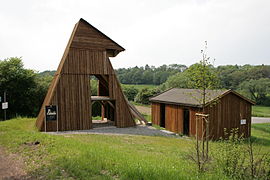Colliery Hermann (Witten)
| Colliery Hermann | |||
|---|---|---|---|
| General information about the mine | |||
| Headframe of the Margarethe shaft | |||
| Funding / year | Max. 2147 t | ||
| Information about the mining company | |||
| Employees | up to 9 | ||
| Start of operation | 1882 | ||
| End of operation | 1891 | ||
| Successor use | United Hermann colliery | ||
| Funded raw materials | |||
| Degradation of | Hard coal | ||
| Geographical location | |||
| Coordinates | 51 ° 25 '20.3 " N , 7 ° 19' 5.5" E | ||
|
|||
| Location | Muttental | ||
| local community | Witten | ||
| District ( NUTS3 ) | Ennepe-Ruhr district | ||
| country | State of North Rhine-Westphalia | ||
| Country | Germany | ||
| District | Ruhr area | ||
The Hermann colliery is a former hard coal mine in Witten -Muttental. The mine was created due to the re- lending of a field part of the Österbank colliery .
history
The beginnings
In 1882 a new guess was made for the length of the disused Österbank colliery. The mine director of the Louisenglück colliery , Dietrich Köllermann , acted as mother . The length of the field, for which he was speculating, had only been partially dismantled by the Österbank colliery. On February 6, 1883, the Österbank authorization was re-granted under the name Hermann. It was awarded to Dietrich Köllermann as a representative . After the award, the mine was put into operation. In the same year was Schacht Margarethe (Tray 1) geteuft . The starting point of the shaft was on Berghauser Strasse near the current car park. The shaft was sunk in the Geitling seam to a shallow depth of 63 meters. To the resulting at depths of tailings to be deposited, one was in the valley Bergehalde piled up. This is also where the tailings from driving the tunnels were heaped up. The colliery was demonstrably in operation in 1884.
The other years
In 1884 a mine house was built next to the Margarethe shaft . The house had three rooms and was equipped with a toilet. In 1886 the pit field of the Herberholz colliery was taken over. This takeover by the Hermann colliery was only possible because the Köllermann main works had taken over part of the disused Herberholz colliery. Despite this takeover, the mine field continued to operate under the name Herberholz. By taking over the Herberholz field, the Hermann colliery was also entitled to mine below the bottom of the tunnel . This made it possible to mine two seams that were located below the bottom of the tunnel. In order to get to the seams, shaft 1 was sunk deeper. Around 1888, a steam engine was installed on the shaft for shaft conveyance . With conveyor buckets coals were in the pit after about day promoted. The buckets were also used for dewatering . This water collected in the shaft sump, especially in wet weather . In 1889, Shaft 2, also called Shaft Anna or New Shaft, was sunk. The Anna shaft, like the Margarethe shaft, was sunk in tons. It was set in the Muttental about 230 meters west of shaft 1 and was sunk to a depth of 84 meters. Underground Anna was equipped with a double plunger pump for water retention, which was driven by a steam engine located above the surface. From now on, shaft 1 was also called the old shaft. On November 2nd, 1891 , the Hermann colliery consolidated with other mines and mine fields to form the United Hermann colliery .
Promotion and workforce
The first known workforce and production figures come from the year 1883, at that time three miners were employed at the mine who produced 23 tons. In 1885, three to four miners extracted 824 tons of hard coal. The maximum extraction was achieved in 1889 by nine miners, 2147 tons of hard coal were extracted, these are also the last known extraction and workforce figures for the mine.
What is left
The mine dump is still reminiscent of the Hermann mine . The overburden was transported over a short track system by means of a trolley out of the tunnel and filled up.
photos
Individual evidence
- ↑ a b c d e f g h i j k l Joachim Huske : The coal mines in the Ruhr area. Data and facts from the beginning to 2005 (= publications from the German Mining Museum Bochum 144) 3rd revised and expanded edition. Self-published by the German Mining Museum, Bochum 2006, ISBN 3-937203-24-9 .
- ↑ a b c d e f g h i Gerhard Koetter (Ed.): Mining in the Muttental. 1st edition, Druckstatt Wöhrle, Witten 2001, ISBN 3-00-008659-5 .
- ↑ a b Wilhelm Hermann, Gertrude Hermann: The old collieries on the Ruhr. 4th edition, Verlag Karl Robert Langewiesche, successor Hans Köster KG, Königstein i. Taunus 1994, ISBN 3-7845-6992-7 .
- ↑ a b Gerhard Koetter (Ed.): From seams, tunnels and shafts in the Muttental. 1st edition, Klartext Verlag, Essen 2007, ISBN 978-3-89861-612-6 .
- ↑ www.7grad.org: The heap of the Hermann colliery (last accessed on May 9, 2014)



